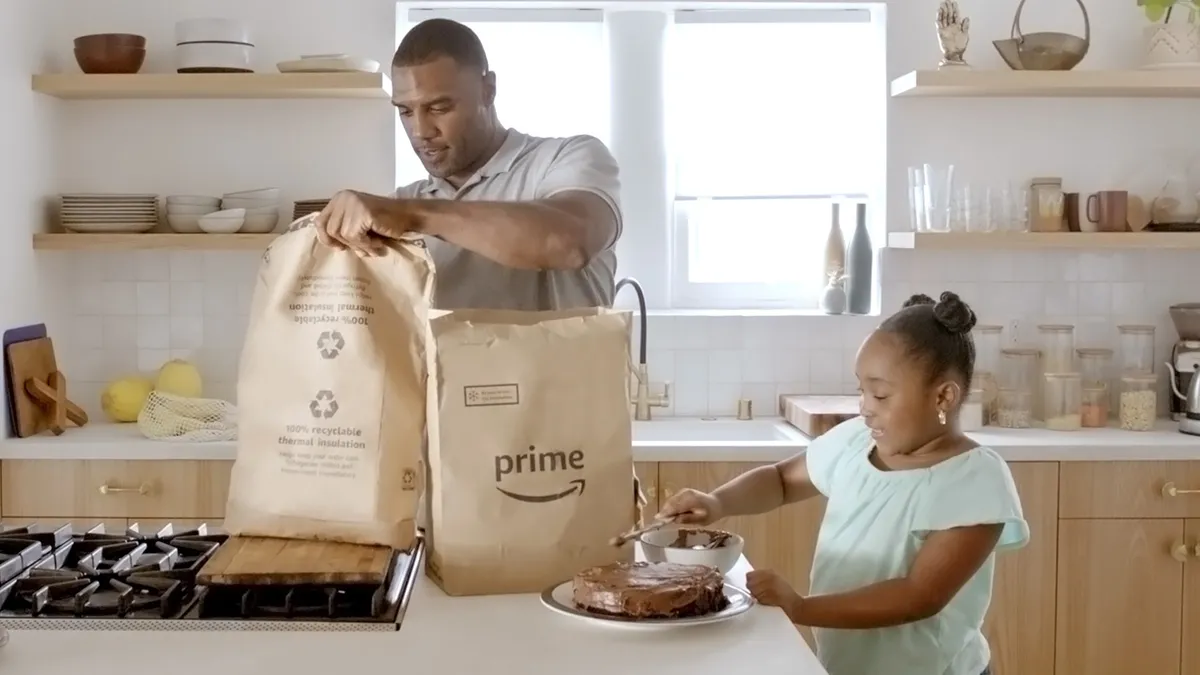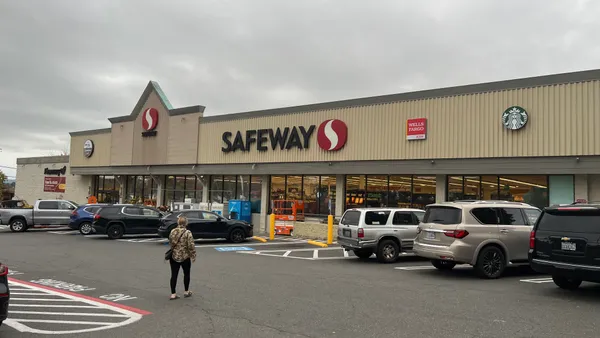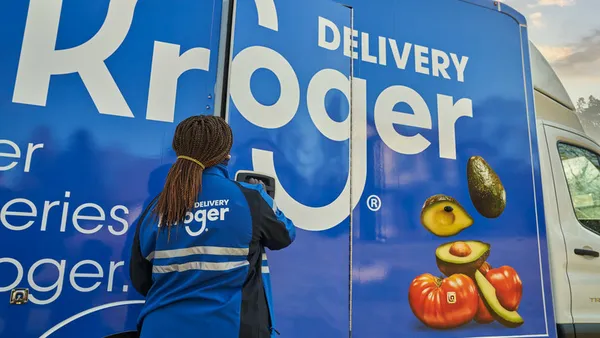Dive Brief:
- The proportion of Amazon Prime members who buy groceries on Amazon is trending downward, according to surveys analyzed in a new report from Coresight Research. In 2022, 56.9% of surveyed Prime members surveyed said they bought groceries online from the retailer in the past year compared to 57.7% who said the same in 2021 and 70.6% in 2018, Coresight found.
- The report, which gives an overview of U.S. grocery e-commerce, noted Amazon is the most shopped online grocery retailer. However, its customers appear to have smaller grocery baskets in comparison to other large retailers — an issue the e-tailer has grappled with for years.
- “Amazon tried to crack online grocery with a purely pure-play presence, and it didn’t really do it very well. … It’s realized you’ve got to have this multichannel proposition in grocery," John Mercer, head of global research at Coresight, said in an interview.
Dive Insight:
While Amazon.com is leading online grocery sales, per Coresight, the report's findings of the declining Prime members shopping the e-tailer's site for groceries reinforces Amazon's decision to bolster its brick-and-mortar presence to help draw customers in with omnichannel shopping.
“[Amazon’s] regular website, delivering items through the mail or similar delivery services, is not set up for a conventional, multi-item grocery basket that would include perishables,” the report said.
Nearly or more than 30% of respondents in Coresight's survey said they do "most" to "all" of their grocery shopping at Walmart, Target, Sam's Club and Costco, while 27.5% said the same for Amazon. A little over half said they do "almost none or a small amount" of their grocery shopping with Amazon, while between 40% to 47.2% said the same for the other four retailers.
Amazon has tried to diversify its grocery e-commerce presence with services like Amazon Fresh, which started as a grocery delivery service in 2007; dry-goods delivery service Prime Pantry; Prime Now, which offered two-hour grocery delivery; and Subscribe & Save, which lets shoppers save money when they set up recurring orders for household essentials.
But many of those services have shuttered or scaled back, and now Amazon is focused on building out its physical footprint for Amazon Fresh and Whole Foods Market, which it bought in 2017, along with offering some food and groceries at its fledging Amazon Go convenience store chain. Amazon's struggle with basket sizes is likely a key reason behind its push into brick-and-mortar sales.
Of the major retailers Coresight studied, Amazon had the largest decline in online grocery shoppers – 11 percentage points – between 2020 and 2022, while Walmart only saw a 1.8 percentage point drop during the same period. Meanwhile, other retailers like Albertsons, Target and Costco each saw increases for those same metrics, at 2.7, 2.6 and 0.5 percentage points, respectively.
For Whole Foods, having a Prime membership seems to play a large role in who shops the chain online. Coresight found that Prime members, at 14.5% of survey respondents, are nearly three times more likely than people who don’t have access to Prime (5.6%) to buy groceries online from the specialty grocer within the last 12 months.
Since 2018, Whole Foods has seen the proportion of Prime members who shop online with the retailer increase from 2.6% in 2018 to 14.5% in 2022.
Online shopping by Prime members is declining at Amazon.com, while increasing at Whole Foods
That sharp uptick in Prime members shopping Whole Foods indicates Amazon's membership program is a powerful weapon in boosting grocery sales. In addition to offering discounts, Prime members also can get delivery and free in-store pickup in select ZIP codes and make in-store payments with the Whole Foods app.
Coresight noted its research only covers either people with Prime memberships and those without access to Prime — and not people who don't personally have Prime but have access to it through someone else, similar to Netflix password sharing.
Meanwhile, omnichannel retailers with strong brick-and-mortar presences are fairing well in online grocery, per Coresight's report. Walmart, which is building omnichannel capabilities and e-commerce after focusing on building out its fleet of stores, has a 2.3:1 ratio of in-store to online shoppers, indicating a large proportion of its customer base engages in omnichannel shopping, Coresight said. Albertsons, Costco and Target have seen an increase from 2020 to 2022 in online grocery shopping that is eating into the margins of Amazon and Walmart, Coresight said.
“I think, especially when consumers have somebody picking their groceries on their behalf, that they often will choose a retailer that they trust to do that. In many cases, that will be a retailer that's familiar to them from in-store shopping,” Mercer said about the e-commerce gains among traditional retailers.












